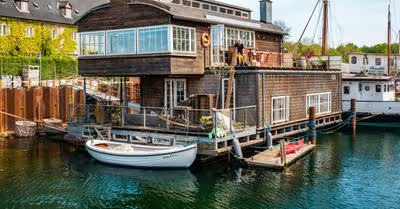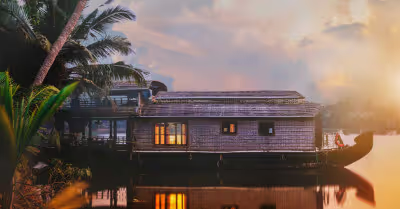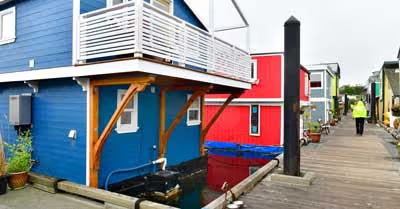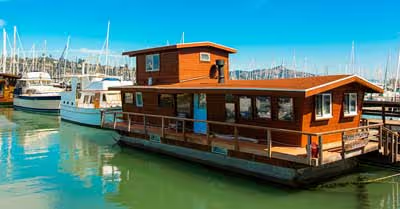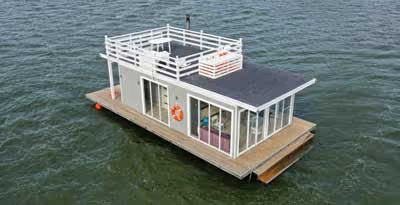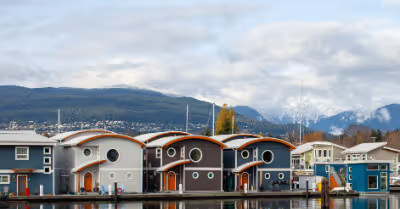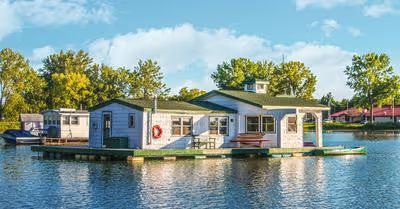
Liveaboard and recreational houseboats may look the same, but they have some notable amenity differences.
The primary difference between liveaboard and recreational houseboats is the amenities. Liveaboard houseboats are designed to offer home-like comforts to a couple of people, whereas recreational houseboats offer basic comforts to ten or more people.
In this article, we'll define the characteristics of both liveaboard houseboats and recreational houseboats. Additionally, we'll go over the similarities and differences between them, along with their possible alternative uses.
We sourced the information used in this article from houseboat manufacturers and the house boating community. Additionally, we analyzed houseboat listings by type to examine the similarities and differences.
What is a Liveaboard Houseboat?
A liveaboard houseboat is a houseboat designed for long-term residency. It has appliances, plumbing, space, and systems designed for regular use. As a result, liveaboard houseboats tend to be slightly more complex but also higher quality than other types of craft.
Types of Liveaboard Houseboats
Liveaboard houseboats come in two basic types. The first is the mobile liveaboard houseboat. It has an engine, rudder, propeller, and a helm for steering and controlling the vessel. These boats are designed to move under their own power, albeit only in calm waters and protected channels.
The second type of liveaboard houseboat is referred to as a 'stationary' houseboat. These vessels are essentially stick-built houses perched on top of barges or pontoons. These are common in areas with expensive real estate, as you can build a relatively normal house on a floating foundation instead of a stone or concrete one.
Features of Liveaboard Houseboats
Liveaboard houseboats tend to be large. They often measure in excess of 30 or 40 feet in length and sometimes around 10 feet in beam (or width). These large craft tend to be boxy, too, as they're designed primarily to sit in one place most of the time, either moored to a dock or out at anchor.
The interiors of liveaboard houseboats range from basic, RV-style facilities to ultramodern lighting, upholstery, and fine household appliances. Due to the shape and dimensions of liveaboard houseboats, they can fit many more household size items than powerboats and sailboats.
Liveaboard houseboat interiors vary widely and fit and finish, but they all have minimum facilities that are necessary for hygiene, cooking, and sleeping. These facilities include a bathroom with a shower, a small kitchen with a stove, sink, and icebox, multiple places to sleep, and usually a sitting area with a table.
Many houseboats also include couches and master suites, and some even include bathtubs. The larger the houseboat, the more luxurious it tends to be. Larger liveaboard houseboats are often equipped with washing machines and dryers and central heating, ventilation, and air conditioning.
What Is a Recreational Houseboat?
Recreational houseboats are often owned by resorts or boat rental agencies. These vessels can look very similar on the outside to liveaboard houseboats, but their floor plans and designs are crafted for excursions and vacation, not long-term living.
Recreational houseboats can also be much smaller than liveaboard houseboats. In some cases, they can also be more seaworthy depending on the location that they're used.
You won't find an ocean-going recreational houseboat, but you may be able to rent a stout motorized houseboat to explore a bay coral reef area.
Characteristics of Recreational Houseboats
Virtually all recreational houseboats have an engine, as the houseboat experience sells best when renters get to take the boat for a ride or find it a secluded anchorage to relax in. The only exceptions are rental vacation houses on pontoons, I.E., stationary rental houseboats. These provide an affordable alternative to renting a vacation condo.
Additionally, they tend to be a bit more robust than run-of-the-mill liveaboard houseboats. This is because the risk of minor collisions is higher with inexperienced drivers. Additionally, lack of care while driving is more common with renters than owners.
The interiors of recreational houseboats tend to be a bit more basic and even spartan in some cases. These vessels are designed to sleep as many people as possible. As a result, the comfort of a single individual isn't of the greatest concern when your boat is taking an entire family on vacation.
Despite their lack of flashy interiors, recreational houseboats have more party-oriented features than liveaboard vessels. These include two, possibly three decks, a covered outdoor patio, a minibar, a swim platform, and a well-designed surround sound system.
On the inside, recreational houseboats include the basics, such as a shower and a kitchen. In some cases, recreational houseboats with a large sleeping capacity have several bathrooms and hotel-like amenities.
Types of Recreational Houseboats
There are two main types of recreational houseboats. The larger variety, which visibly resembles the average liveaboard houseboat, is the most common in recent years and also the most comfortable. These are the 'party houseboats' with space for an entire family or a large group of friends.
Large recreational houseboats, which are over 40 feet in length, can comfortably sleep and entertain ten or more people. Sleeping arrangements may be a bit close, but there's plenty of deck and interior seating space to spread out around during the day.
Smaller recreational houseboats usually sleep between two and four people, and they're easy to maneuver for exploring Lakes and designed for spending more time underway. These vessels have accommodations similar to sailboats or powerboats but slightly more room due to their boxy appearance.
Features of Recreational Houseboats
Recreational houseboats feature everything you need to have a good time. After all, they're designed for parties and vacations. As we mentioned previously, recreation houseboats tend to have a much larger sleeping capacity. This usually comes in the form of bunks or convertible seating areas.
These vessels also have a sun deck for relaxation, along with patio-style furniture for outdoor dining. Some of these vessels have a barbecue, tiki torches, and other miscellaneous items that consumers and renters look for. There are usually cupholders dotted along with seating areas as well, along with provisions for tubing and swimming.
Differences between Recreational and Liveaboard Houseboats
The biggest differences between recreational and liveaboard houseboats are sleeping capacity and interior amenities. Exterior features, such as additional decks and a swim platform, are still fairly common on both recreational and liveaboard houseboats.
The interior of a liveaboard houseboat will have more space and more luxurious amenities, even if it's the same length and width as a physically identical recreational model. This is because recreational houseboats sacrifice things like laundry facilities, large appliances, and master bedroom space in order to sleep more people comfortably.
Similarities of Recreational and Liveaboard Houseboats
Liveaboard and recreational houseboats actually have more similarities than differences. Other than layout, the vast majority of recreational houseboats are simply decked-out versions of production liveaboard models.
That's why a houseboat owner may see the same model of boat for rent on a vacation site but arrive to find completely different interior facilities. Remember, most production houseboats are designed to be a home.
Engines, handling characteristics, and even tank capacity are often exactly the same for the liveaboard and recreational versions of a production houseboat. Many companies order custom floor plans to suit their target market, but the rest of the boat and its systems usually remain untouched.
Can You Live on a Recreational Houseboat?
Yes, you can absolutely live on a recreational houseboat. Like we mentioned earlier, the majority of the systems that make the vessel work are the same or very similar. Sometimes, they're more basic but also more durable and long-lasting.
You'll have a bathroom, bathing facilities, a kitchen, and more room than any other kind of boat in a similar size category. You can also modify a used recreational houseboat with more home-like facilities, which can greatly increase your comfort.
Are Recreational Houseboats More Expensive?
Generally, recreational houseboats are actually less expensive than liveaboard versions. This is because the cost of appliances and materials aboard recreational boats is usually lower.
Also, the overall fit and finish of the vessel (inside and out) is more utilitarian and less premium than on liveaboard models. Recreational houseboats may have more stuff inside, but that stuff is usually less costly.



